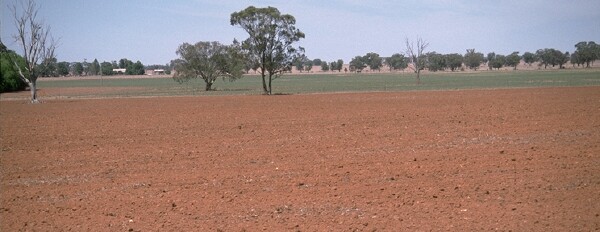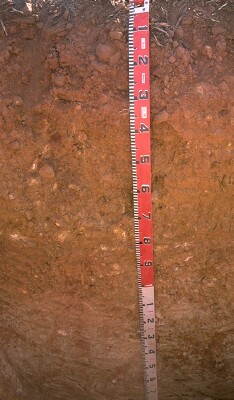LP36
| Group: Bridgewater Farm Advance | Australian Soil Classification: Sodic, Eutrophic, Red CHROMOSOL |
| Northcote Factual Key: Dy 2.23 | Great Soil Group: no suitable group |
| General Landscape Description: Crest of a low rise. | |
 LP36 Landscape |
Soil Profile Morphology
Surface Soil
| A1 | 0-10 cm | Dark reddish brown (5YR3/4); fine sandy clay loam; massive; firm consistence dry; contains very many (50%) basalt and sandstone fragments; pH 6.0; abrupt and smooth change to: |  LP36 Profile |
| A2 | 10-15 cm | Red (2.5YR5/7); fine sandy clay loam; some development of platy fragmentation; strong consistence dry; contains many (20-50%) amount of basalt and sandstone fragments; pH 5.5; clear and smooth change to: | |
| Subsoil | |||
| B21 | 15-30 cm | Red (2.5YR5/8); light clay (fine sandy); moderate medium angular blocky, breaking down to fine blocky structure; strong consistence dry; contains many (20-50%) basalt and sandstone fragments; pH 5.8; clear and smooth change to: | |
| B22 | 30-50 cm | Strong brown (7.5YR5/8) with dark red (2.5YR3/6); medium clay; moderate medium angular blocky, breaking down to strong fine angular blocky structure; strong consistence dry; contains a common (10-20%) amount of basalt and sandstone fragments; pH 6.3; clear and smooth change to: | |
| B23 | 50-80 cm | Yellowish brown (10YR5/6) with yellowish red (5YR4/6); medium clay; moderate coarse prismatic structure (with shiny faced peds); very strong consistence dry; contains a common (10-20%) amount of basalt and sandstone fragments; pH 6.4; clear change to: | |
| B31 | 80+ cm | Light yellowish brown (10YR6/4) with dark yellowish brown (10YR3/4); heavy clay; strong coarse prismatic structure; very strong consistence dry; contains dark flecks as well as many (30-40%) basalt and sandstone fragments; pH 8.6. | |
Key Profile Features
- Strong texture contrast between the surface (A) horizons (clay content 21%) and the top of the subsoil (B) horizon (clay content 43%).
Key Profile Characteristics
pH | Salinity Rating | |||
Surface (A1 horizon) | moderately acid | very low | non-sodic | none1 |
Subsoil (B21 horizon) | moderately acid | very low | non-sodic | none2 |
Deeper subsoil (at 1 m) | strongly alkaline | very low | sodic | __ |
| 1 Slight dispersion with remoulding 2 Strong dispersion with remoulding | ||||
 |
Management Considerations:
Surface (A) Horizons
- The surface horizon has a high fine sand content (45 %) which will result in the soil becoming "powdery" when cultivated dry. This may result in surface crusting developing with subsequent heavy rainfall. Improving organic matter levels will help reduce the likelihood of structural degradation and minimise hardsetting.
- The surface horizon has a moderate overall nutrient status.
- Cultivation of such soils when wet may lead to structural degradation (as indicated by slight dispersion after remoulding).
- The large amount of rock fragments are likely to interfere with cultivation.
- The subsurface (A2) horizon is strongly acid. This indicates that aluminium and manganese toxicity may occur. Raising the pH level of the soil will help reduce many toxic effects. A lime test (at the paddock level) may be appropriate.
- The development of platy fragmentation in the subsurface A2 horizon indicates that the soil may have been cultivated when too wet, leading to compaction and plough pan development.
Subsoil (B) Horizons
- The top of the subsoil is non-sodic but will disperse strongly when remoulded. Disturbance to this horizon through cultivation when wet may result in dispersion and resultant structural breakdown.
- The deeper subsoil becomes sodic (and also has a low calcium:magnesium ratio) and root and water movement may be restricted from 50 cm depth.
Notes
- Profile described by Mark Imhof, Paul Rampant and Sonia Thompson (14/2/95)


